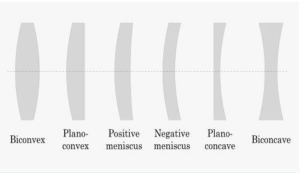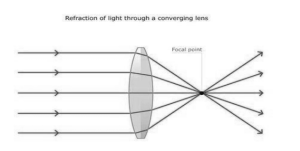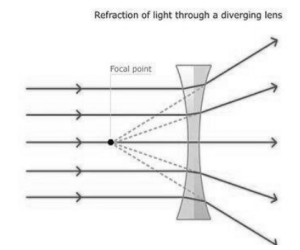An individual piece of transparent material serves as the basis for a simple lens; however, compound lenses are constructed by aligning a number of simple lenses around one another along the same common axis. In contrast to a prism, which refracts light without focusing it, a lens can concentrate light to produce an image, but a prism does not focus light at all.
The primary function of lenses is to regulate light, and as such, they are employed for both light collection and picture production. When it comes to light gathering and image generation, curved mirrors and lenses may achieve many of the same tasks as flat mirrors and lenses. Although lenses are transparent, they tend to be preferable in terms of picture generation because they allow light to be transported directly along the axis to the detector, as opposed to the off-axis geometry required by mirrors. When it comes to light collection, mirrors are often favoured since they can be made substantially more lightweight than lenses, allowing for wider diameters and more light collecting ability.
Lenses are available in a number of shapes, including biconvex and biconcave, plano-convex and plano-concave, positive meniscus and negative meniscus, and plano-convex and plano-concave.

Positive (or converging) lenses are distinguished from negative (or diverging) lenses, which are distinguished from each other.
After passing through the lens, a collimated beam of light will converge or focus on a spot behind the lens. This is assuming that the collimated beam is travelling parallel to the lens axis and passing through the lens. Using the image above as a guide, biconvex and plano-convex lenses are regarded as positive lenses.

When a collimated light beam passes through a negative lens, the beam becomes divergent and spreads behind the lens. Biconcave and plano-concave lenses are the two forms of concave lenses that are considered negative.

Convex-concave lenses, a third broad form of lens that can be either positive or negative depending on the curvature of both sides of the lens, are a third wide type that can be either positive or negative. It is negative when the concave surface of the meniscus lens is steep, whereas it is positive when the convex surface of the lens is steep. Neither convergent nor divergent light would pass through a meniscus lens with equal curvature on both sides.
CLASSIFICATION OF LENSES
Spherical Lenses
Spherical lenses (also known as singlets) are lenses with curved surfaces that can either converge or diverge rays. All of the cross-sections of the lenses are spherical lenses.
Cylindrical Lenses
Cylindrical lenses, in contrast to spherical lenses, feature curved faces that might be considered to be a component of the cylinder shape. In order to avoid focusing transmitted light on a single spot, they focus it on a line instead. When it comes to changing the aspect ratio of an image or shaping a laser beam, cylindrical lenses are frequently used in the industry.
Achromats
Achromats (also known as achromatic lenses) are optical elements that are used to reduce chromatic aberration, a sort of visual distortion that is unique to photography. Colour fringing and blurred contrast are caused by a lens failing to focus all colour wavelengths to the same convergence point, which results in blurred contrast and colour fringing. Achromats produce their corrective effect by combining at least two different lens elements — one concave lens with high dispersion and one convex lens with low dispersion — to generate their corrective effect.
Fresnel Lenses
Fresnel lenses are made out of thin, lightweight plastic sheets that have been imprinted with a series of concentric grooves to give them their shape. Each groove acts as a refracting surface in its own right, and the series of grooves bends collimated light into a single point at the centre of the image. Fresnel lenses are a balance between efficiency and optical quality: because the lens material is very thin, only a very small quantity of light is lost during the transmission process, making Fresnel lenses an excellent choice for low-light applications.
Applications Of Lens
So, what do a magnifying lens, your eye, and a pair of binoculars all share in common? They are all equipped with convex lenses. And have any of you ever pondered why people appear to be acting strangely when you glance at them via a peephole? This is due to the fact that the glass used there is not standard. It is a lens with a concave surface. Convex lenses are used to correct farsightedness in people who are nearsighted.
Concave lenses are also used to treat nearsightedness, and they are similar in appearance. Convex and concave lenses are used in the construction of compound microscopes and telescopes. When using a combination of convex lenses, it is possible to get hazy images. In order to correct this issue, a concave eyepiece is used. Even in cameras, it is possible to utilise a combination of concave and convex lenses from time to time. In lasers, the usage of concave lenses is absolutely necessary. The real light ray is quite particular, which may cause harm to equipment in the area where it is employed (like CDs and scanners). This problem is resolved by using a diverging lens. Concave lenses are also used in flashlights, where the light beam diverges in order to cover a larger amount of ground.
Conclusion
Singly capable of forming images (such as the bi-convex lens), single lenses are useful in instruments meant for simple magnification applications, such as magnifying glasses, eyeglasses, single-lens cameras, loupes, viewfinders, and contact lenses. Singly capable of forming images The most basic doublets (two-lens systems) are known as achromatics, and they are made up of two lens elements that are cemented together in order to correct for spherical and chromatic aberrations that occur on the optical axis. Achromatic doublets are often composed of a bi-convex lens coupled to either a positive or negative meniscus lens or to a plano-convex lens, with the bi-convex lens serving as the primary lens. Triplet achromats (which have three lens elements) are used as high-power magnifiers and relay lenses, among other applications. Triplet lens combinations are typically improved by computer design approaches to almost remove distortion, as they are more highly compensated for aberration than doublet lens combinations. More complicated devices frequently make use of a mix of many lens components to increase magnification while also taking advantage of other optical features of the picture being magnified. Microscopes, telescopes, periscopes, cameras, and binoculars are just a few of the equipment that make use of compound optical systems, which include a wide range of other items.
 Profile
Profile Settings
Settings Refer your friends
Refer your friends Sign out
Sign out






